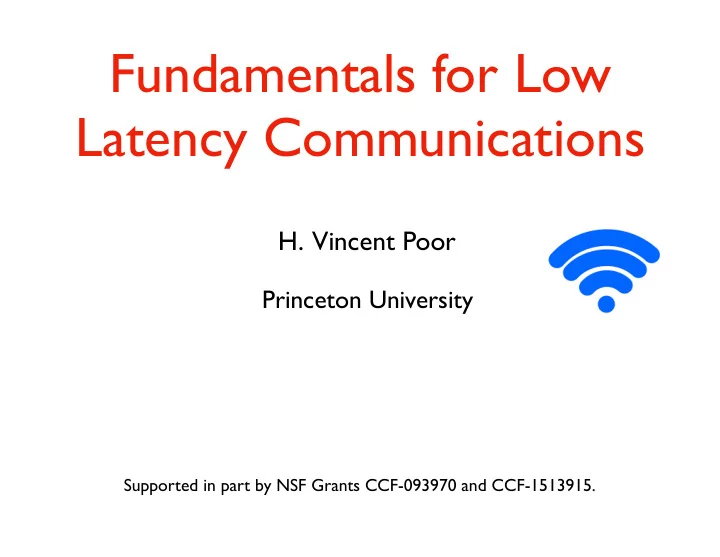

Fundamentals for Low Latency Communications H. Vincent Poor Princeton University Supported in part by NSF Grants CCF-093970 and CCF-1513915.
The Internet-of-Things (IoT) Vision • Interconnecting perhaps100s of billions of devices • Key enabler: wireless communications
Salient Characteristics of IoT • Massive connectivity • High energy efficiency • Low complexity • High reliability • Short packets • Low latency
Requirements for URLLC in 5G [3GPP TS22.261] Table 7.2.2-1 Performance requirements for low-latency and high-reliability scenarios. Scenario End-to- Jitter Survival Communication Reliability User Payload Traffic Connection Service area end time service (note 4) experienced size density density dimension latency availability data rate (note 5) (note 6) (note 7) (note 8) (note 3) (note 4) 2 2 Discrete automation – 1 ms 1 µs 0 ms 99,9999% 99,9999% 1 Mbps Small 1 Tbps/km 100 000/km 100 x 100 x 30 m motion control up to 10 Mbps (note 1) 2 2 Discrete automation 10 ms 100 µs 0 ms 99,99% 99,99% 10 Mbps Small to big 1 Tbps/km 100 000/km 1000 x 1000 x 30 m 2 2 Process automation – 50 ms 20 ms 100 ms 99,9999% 99,9999% 1 Mbps Small to big 100 Gbps/km 1 000/km 300 x 300 x 50 m remote control up to 100 Mbps 2 2 Process automation ‒ 50 ms 20 ms 100 ms 99,9% 99,9% 1 Mbps Small 10 Gbps/km 10 000/km 300 x 300 x 50 monitoring 2 2 Electricity distribution – 25 ms 25 ms 25 ms 99,9% 99,9% 10 Mbps Small to big 10 Gbps/km 1 000/km 100 km along power medium voltage line 2 2 Electricity distribution – 5 ms 1 ms 10 ms 99,9999% 99,9999% 10 Mbps Small 100 Gbps/km 1 000/km 200 km along power high voltage (note 9) line (note 2) 2 2 Intelligent transport 10 ms 20 ms 100 ms 99,9999% 99,9999% 10 Mbps Small to big 10 Gbps/km 1 000/km 2 km along a road systems – infrastructure backhaul Tactile interaction 0,5 ms TBC TBC [99,999%] [99,999%] [Low] [Small] [Low] [Low] TBC (note 1) Remote control [5 ms] TBC TBC [99,999%] [99,999%] [From low to [Small to [Low] [Low] TBC 10 Mbps] big] NOTE 1: Traffic prioritization and hosting services close to the end-user may be helpful in reaching the lowest latency values. NOTE 2: Currently realised via wired communication lines. NOTE 3: This is the end-to-end latency the service requires. The end-to-end latency is not completely allocated to the 5G system in case other networks are in the communication path. NOTE 4: Communication service availability relates to the service interfaces, reliability relates to a given node. Reliability should be equal or higher than communication service availability. NOTE 5: Small: payload typically ≤ 256 bytes NOTE 6: Based on the assumption that all connected applications within the service volume require the user experienced data rate. NOTE 7: Under the assumption of 100% 5G penetration. NOTE 8 Estimates of maximum dimensions; the last figure is the vertical dimension. NOTE 9: In dense urban areas. NOTE 10: All the values in this table are targeted values and not strict requirements.
Talk Outline • Traditional information theory - asymptotic performance • Basics of finite blocklength information theory: point-to-point • Multipoint - network models • Age-of-Information (briefly) • Conclusion
Traditional Information Theory
Traditional Information Theory • Point-to-point: Shannon’s pioneering work • Data transmission • Data compression • Network information theory • Broadcast, multiple access, relay • Secure transmission (wiretap), secure compression • Asymptotic: characterizes fundamental limits when delay is unimportant • Benefit: characterizes operational, engineering problems in terms of elegant mathematical formulas • Limitation: not suitable for low-latency applications as in IoT
Recommend
More recommend